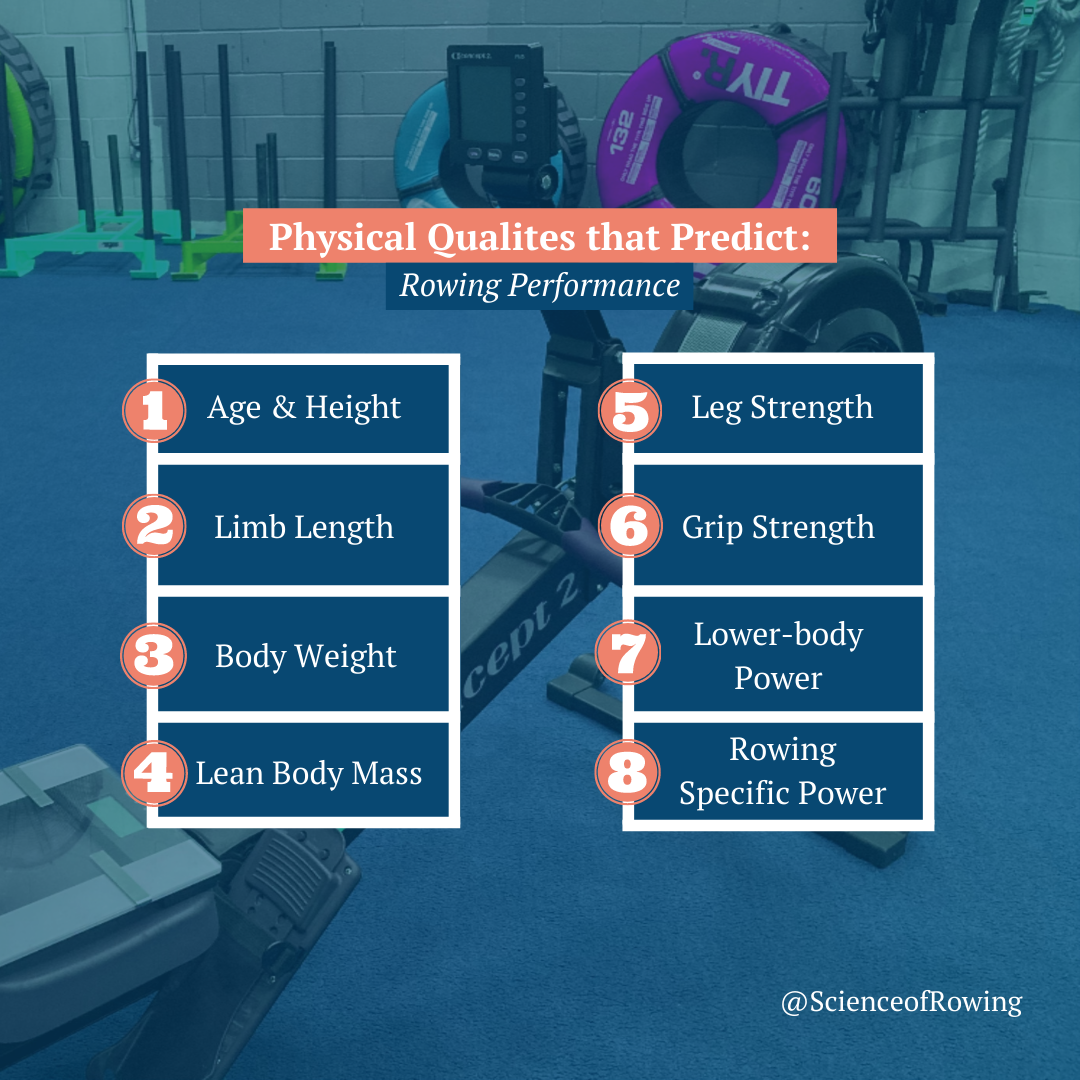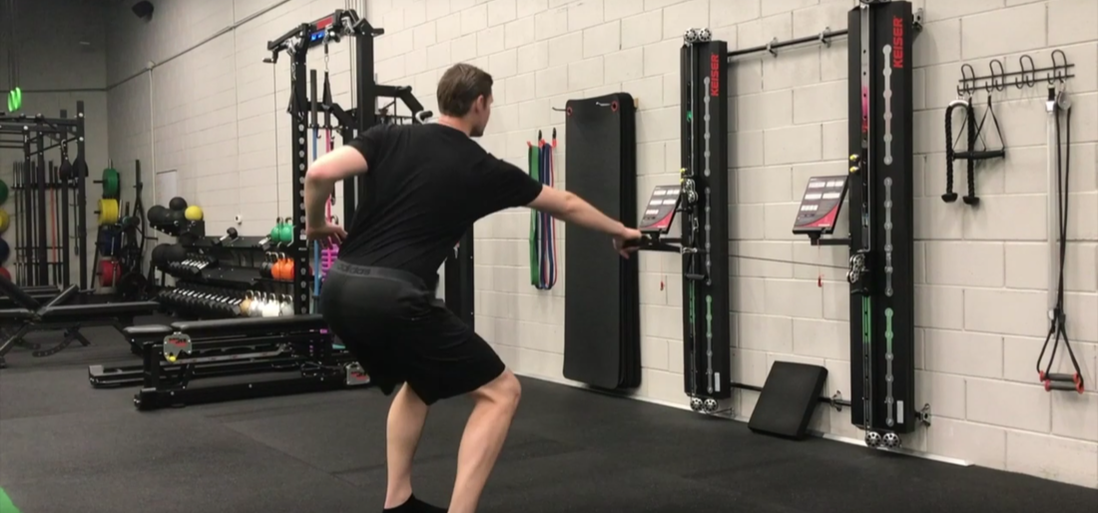"Research identifies drive speed as critical for rowing performance and it may be even more important to rowing performance after establishing substantial strength" Interested in a quick summary? Watch the video below. If you want more details read the entire blog post! The Video The Why As you can see in the image above, there are many qualities that predict rowing performance. Although we can't control all of these variables we do have control over a few. The few that we have control over include: movement, strength, power, lean body mass, and conditioning. For the purpose of this blog post we're going to focus on power. As it relates to power, rowing researchers over the years have found that the following variables positively predict rowing performance: 1) Mean peak force of a counter-movement jump (1) 2) Peak rowing power (2) 3) Vertical jump height (3) 4) Strength and power (4) 5) Maximum force and power (5) 6) Counter-movement jump height (7) 7) A 10 second all out rowing sprint, and peak power during a 6k rowing test (8). Research identifies drive speed as critical for rowing performance and it may be even more important to rowing performance after establishing substantial strength (6). After you've established a solid foundation of movement and strength a focus on developing power should be your next step. What constitutes strong enough? Below is an image that summarizes the standards that I look for in rowers. Please note that your standards will vary based on your demographic. The How There are many ways to introduce and develop the ability to produce power. To improve power production, rowers may perform standard lifts with an emphasis on accelerating away from the floor, incorporate plyometrics such as box jumps and medicine ball throws, use specific methods like the kettlebell swing, or utilize strength and power contrast training. To improve rowing specific power rowers can utilize short intervals with complete recovery. Plyometrics WHY I use plyometrics to teach rowers how to produce force quickly and how to absorb that same force. This should help rowers improve their ability to accelerate, increase their resilience, and have a quicker turn around at the catch. SETS & REPS Lower-body: 1-3 sets x3-5 repetitions Upper-body: 1-3 sets x5-12 repetitions INTENSITY As explosive as possible! EXERCISE CHOICE I'll typically choose one plyometric for the lower-body and one for the upper-body. My go to exercises are the box jump and med-ball chest pass. You can view videos of all of the plyometric progressions that I use here. Specific Methods WHY The weight of the rowing stroke ranges from 56-166 pounds over the course of a 2K. If we aren't able to move weight with speed we won't be able to transfer that speed over to the rowing stroke. Using heavy implements to develop power is one way to meet those demands. SETS & REPS 1-3 Sets x3-8* repetitions *For kettlebell swings x8-20 repetitions INTENSITY Use a load that challenges you but allows you to be explosive. If the weight isn't flying lower the load until it does. EXERCISE CHOICE I'll typically choose one exercise to perform after my warm-up but before I start lifting weights. My go-to exercises for this category include kettlebell swings, dumbbell snatches, and sandbag cleans. You can view videos of all of the power methods that I use here. Accelerated Intent WHY Lifting with an accelerated intent has similar benefits as the specific methods mentioned in the section above. Can we accelerate a weighted object at a speed similar to our drive speed? SETS & REPS 1-3 Sets x3-8 repetitions INTENSITY Use a load that challenges you but allows you to accelerate at a speed that's similar to your drive speed. EXERCISE CHOICE My go-to exercises for this category include accelerated deadlifts, and speed rows. Contrast Training WHY One of my favorite ways to develop power is the contrast training method. This method combines a heavy lift with a similar but lighter and explosive movement. This method takes into account the power equation. Power = Force x Velocity When we improve the amount of weight that we can lift we're improving the force side of the equation. When we improve the speed at which we can produce that movement we're improving the velocity side of the equation. Contrast training allows us to develop both sides of the power equation. SETS & REPS Heavy: 1-5 sets x1-5 Explosive: 1-3 sets x3-8* *For kettlebell swings x8-20 repetitions INTENSITY Heavy: Choose a weight that challenges you but allows you to maintain form. Explosive: Choose a weight that allows you to be as explosive as possible. EXERCISE CHOICE Once every 3 months I'll spend 3-4 weeks using contrast training as my main strength training method. My go-to exercise pairs for this category include trapbar deadlifts w/ medball deadlift jumps & 2kb front squats w/ jumps. Rowing Specific Power WHY Rowing specific power is also extremely valuable and the most relevant to our rowing performance. However, most of the the time the way we train doesn't improve our rowing specific power. In order to train for rowing power we need to keep the duration short, and the recovery complete. I use two different methods for these intervals. Sometimes I'll use time and other times I'll use max wattage and heart rate to determine the duration, recovery, and number of repetitions. SETS & REPS: Time-based 1 Set of 5-20 minutes total (including recovery time) Interval Duration: 10-20 seconds Recovery: Complete Before starting each interval you should feel like you're ready to match or beat your last effort. Paddle lightly for 50sec-100sec or until you reach 50-65% of your MaxHR. Repeat until time is up or until you can no longer match or beat your previous interval. SETS & REPS: Wattage/heart rate-based 1 Set of 5-20 minutes total (including recovery time) Interval Duration: Row as hard as you can until you reach your peak power (the split will no longer drop or the wattage will no longer rise, you've reached your peak). Recovery: Complete Before starting each interval you should feel like you're ready to match or beat your last effort. Paddle lightly for 50sec-100sec or until you reach 50-65% of your MaxHR. Repeat until time is up or until you can no longer match or beat your previous interval. INTENSITY Max effort, no rate cap! Caution: These are max effort and it doesn't take much to exhaust you. Start with 5mins and build from there based on your fitness level. More power to you! [1] Bootes, M. (2017) The relationship between rowing ergometer power and jumping characteristics. Journal of Australian Strength and Conditioning 25(6): 50. [2] Bourdin, M, Messonnier, L, Hager, J, and Lacour, J. (2004). Peak power output predicts rowing ergometer performance in elite male rowers. International Journal of Sports Medicine 25(5): 368-373. [3] Chun-Jung, H, Nesser, T, and Edwards, J. (2007) Strength and power determinants of rowing performance. Journal of Exercise Physiology Online 10(4): 43-50. [4] Gee, T, Olsen, P, Fritzdorf, S, White, Golby, J, and Thompson, K. (2012). Recovery of rowing sprint performance after high intensity strength training. International Journal of Sports Science and Coaching 7(1): 109-120. [5] Ingham, S, Whyte, G, Jones, K, and Nevill, A. (2002). Determinants of 2,000 m rowing ergometer performance in elite rowers. European Journal of Applied Physiology 88(3): 243-246. [6] Kolumbet, A, Babina, N, Babina, T, Dudorova, L, and Natroshvili, S. (2018). Study of the rowing technique major components. Journal of Physical Education and Sport 18: 1886-1889. [7] Penichet-Tomás, A, and Pueo, B. (2017). Performance conditional factors in rowing. Factores condicionales de rendimiento en remo. Retos: Nuevas Perspectivas de Educación Física, Deporte y Recreación 32: 238-240. [8] Šmída, M, Clementis, M, Hamar, D, and Macejková, Y. (2017). Relation between maximal anaerobic power output and tests on rowing ergometer. Acta Facultatis Educationis Physicae Universitatis Comenianae 57(1): 68-75.
0 Comments
Leave a Reply. |
Author
Blake Gourley holds a Masters of Science in Sports Performance Training and has over 12+ years of experience working with rowers. Read more Categories
All
Archives
August 2023
|










 RSS Feed
RSS Feed